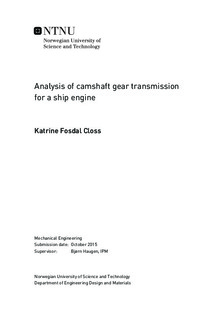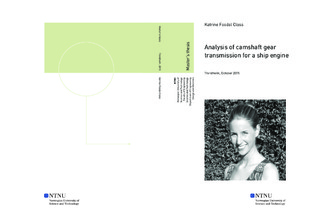| dc.description.abstract | This thesis investigates the dynamic behavior of a spur gear pair. The gears studied
are somewhat similar to the ones found in Bergen Engines medium-speed diesel
engine with regards to design, but some assumptions have been made when it comes
to stiffness and damping. Gear components are an important part in advanced
machines and have been a subject of studies due to increasing demands for higher
performance and reliability and noise control.
At first a dynamic model of a spur gear including time varying mesh stiffness and
backlash is established in Fedem to be analyzed. The complicated phenomenon of
tooth contact alternating between variable number of teeth pairs in contact and
the presents of backlash, cause additional dynamic forces and is the main source of
gear vibration. Backlash is unavoidable but also necessary in gear transmission
preventing the teeth from jamming and allowing room for lubrication. The effect
of backlash cause tooth separation and lead to contact loss during meshing.
Parametric studies were conducted to examine the effects of the following variables;
backlash, torque and rotational speed. For a system with no backlash, the gear
teeth remained in contact throughout the gear mesh and did not experience contact
loss or tooth separation. For small values of backlash, the analysis showed zero
values for the moment which is a result of tooth separation. The time of contact
loss increased with increasing value of backlash.
For a systems with a given constant backlash, the variation in torque appeared as
different values of time of contact loss. For decreasing values of torque the time of
the tooth separation increased.
The analysis clearly shows that the model experience backside contact. Backside
contact is a result of backlash and fluctuations caused by the time varying mesh
stiffness due to the contact ratio alternating between number of teeth in contact.
When these fluctuations coincide with the natural vibration, resonance occur and results in backside contact.
The results were in good agreement with the expectations and analytically showed
the effects off backlash. The gears experience significant dynamic contributions as
a cause of backlash and time variant mesh stiffness. | |

